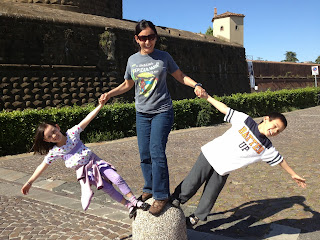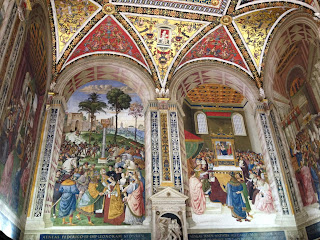Our second long weekend was to
Florence. We had been to Florence
before, but always regretted not going to the Uffizi gallery, one of the most
famous museums in the world. We also
regretted not seeing the David statue, which is housed at the Galleria dell'Accademia, but this would have to wait for
another trip. A visit to the Uffizi
would only take a day, so we used the other day to take a Tuscany tour of the
historic towns of Siena and Luca, visit the leaning tower of Pisa, and try out
some Chiantti at Machiavelli’s estate.
We took the train down to Florence on Friday, a full day train ride, to
start our tour on Saturday morning. We
stayed just outside of Florence, so it was easy to get back to the Florence
train station on Saturday morning for the start of our tour. We left by bus for Siena.
In Siena, we had a fully guided tour of the city for an hour and a half, visiting its medieval center, a UNESCO World Heritage site. We saw the winding streets and sprawling piazzas of the city, including one of Italy's most impressive central squares, the Piazza del Campo. We also visited Duomo, one of Italy's most impressive Gothic cathedrals. Our guide walked us through the incredible marble floor, which holds about 56 panels telling historical and biblical tales, and the frescoes and artworks that span seven centuries of dedication.
We next got back on the bus and drove through the famous Chianti Classico area, perhaps Italy's foremost wine-producing region. We visited the Machiavelli estate which dates all the way back to 1512 and was once home to the famous Renaissance writer, philosopher, humanist and historian Niccolò Machiavelli (writer of “The Prince”). We explored the house museum and had an apero in the wine cellar, where we tasted a red Chianti and a white Vernaccio, and also had some very tasty apps. As part of the tour, we saw the secret basement passageway where Machiavelli would escape to the outdoors as a child. We then had lunch consisting of a variety of typical Tuscan delicacies, all prepared onsite, washed down with a selection of locally produced Chianti Classico wines. We started our meal with a wine tasting of three wines - one white (a Trebbiano), one red Chianti Classico from the region, and one distinguished red Chianti Classico Reserva. Lunch started with an assortment of mixed Tuscan crostini, bread with mixed toppings. The main course was penne with wild boar sauce; Dessert consisted of Italian gelato (ice cream) with berry sauce.
We then visited another medieval town called Luca - a vastly different city to any other in the region. Lucca managed to survive WWII without any bombing, and as such, its streets trace a journey through history, from Etruscan ruins to a Roman-designed street pattern, an old Roman Forum, a medieval tower and Renaissance churches. We had 1 hour to visit these sites and the Holy Face of Lucca in the Duomo, a crucifix said to date back almost to the time of Christ.
Our last stop of the day was Pisa. We took the mini train to Piazza dei Miracoli, where sits the city's main cathedral and the world-famous Leaning Tower of Pisa. We climbed the stairs to the top, feeling the strange pull of gravity each time we completed a level on our way to the top.
Our next day started with a visit to the
Uffizi museum. We ordered “skip the
line” passes ahead of time, so we needed to arrive at a designated time and
then had two hours to tour the museum.
There were a couple of wings that were closed, but all in all it holds
an impressive collection and was worth the visit. We then spent the rest of the day wandering
around Florence and visiting some of the main sites.
Florence is known as the "cradle of the Renaissance" for its monuments, churches and buildings. The best-known site of
Florence is the domed cathedral of the city, Santa
Maria del Fiore, known as The Duomo, whose dome was built by Filippo
Brunelleschi. The nearby Campanile (partly
designed by Giotto) and the Baptistery buildings are also highlights. The dome, 600 years after its
completion, is still the largest dome built in brick and mortar in the
world. In 1982, the historic centre of
Florence was declared a World
Heritage Site by the UNESCO. The
centre of the city is contained in medieval walls that were built in the 14th
century to defend the city. At the heart of the city, in Piazza della Signoria, is Bartolomeo
Ammanati's Fountain of Neptune (1563–1565), which is a masterpiece
of marble
sculpture at the terminus of a still-functioning
Roman aqueduct.
The layout and structure of Florence in many ways harkens back to the
Roman era, where it was designed as a garrison
settlement. Nevertheless, the majority of the city was built during the Renaissance. Despite the strong presence of Renaissance architecture within the
city, traces of medieval, Baroque, Neoclassical and modern
architecture can be found. The Palazzo Vecchio as well as the Duomo, or the city's Cathedral, are the two buildings
which dominate Florence's skyline.
The River Arno, which cuts through the old part of the city, is as much a character in
Florentine history as many of the people who lived there. Historically, the
locals have had a love-hate relationship with the Arno – which alternated
between nourishing the city with commerce, and destroying it by flood.
One of the bridges in particular stands out – the Ponte Vecchio (Old Bridge), whose most striking feature is the multitude of shops
built upon its edges, held up by stilts. The bridge also carries Vasari's elevated corridor linking the Uffizi to the Medici residence (Palazzo Pitti). Although the original bridge was constructed by the Etruscans, the current bridge was rebuilt in the
14th century. It is the only bridge in the city to have survived World War II
intact. It is the first example in the western world of a bridge built using segmental
arches, that
is, arches less than a semicircle, to reduce both span-to-rise ratio and the
numbers of pillars to allow lesser encumbrance in the riverbed (being in this
much more successful than the Roman Alconétar
Bridge).
The church of San Lorenzo contains the Medici Chapel, the mausoleum of the Medici family—the most powerful family in Florence from the 15th to the 18th century.
Nearby is the Uffizi Gallery, one of the finest art museums in the world – founded on a
large bequest from the last member of the Medici family.
The Uffizi is located at the corner of Piazza della Signoria, a site important for being the
centre of Florence's civil life and government for centuries. The Palazzo della Signoria facing it is still home of the
municipal government. The Loggia dei Lanzi provided the setting for all the public ceremonies of the republican
government. Many significant episodes in the history of art and political changes were staged here, such as:
- In 1301, Dante was sent into exile from here (commemorated by a plaque on one of the walls of the Uffizi).
- On 26 April 1478, Jacopo de' Pazzi and his retainers tried to raise the city against the Medici after the plot known as The congiura dei Pazzi (The Pazzi conspiracy), murdering Giuliano di Piero de' Medici and wounding his brother Lorenzo. All the members of the plot who could be apprehended were seized by the Florentines and hanged from the windows of the palace.
- In 1497, it was the location of the Bonfire of the Vanities instigated by the Dominican friar and preacher Girolamo Savonarola
- On 23 May 1498, the same Savonarola and two followers were hanged and burnt at the stake. (A round plate in the ground marks the spot where he was hanged)
- In 1504, Michelangelo's David (now replaced by a replica, since the original was moved in 1873 to the Galleria dell'Accademia) was installed in front of the Palazzo della Signoria (also known as Palazzo Vecchio).
The Piazza della Signoria is the location
of a number of statues by other sculptors such as Donatello, Giambologna, Ammannati and Cellini, although some have been replaced with copies to preserve the
originals.












































